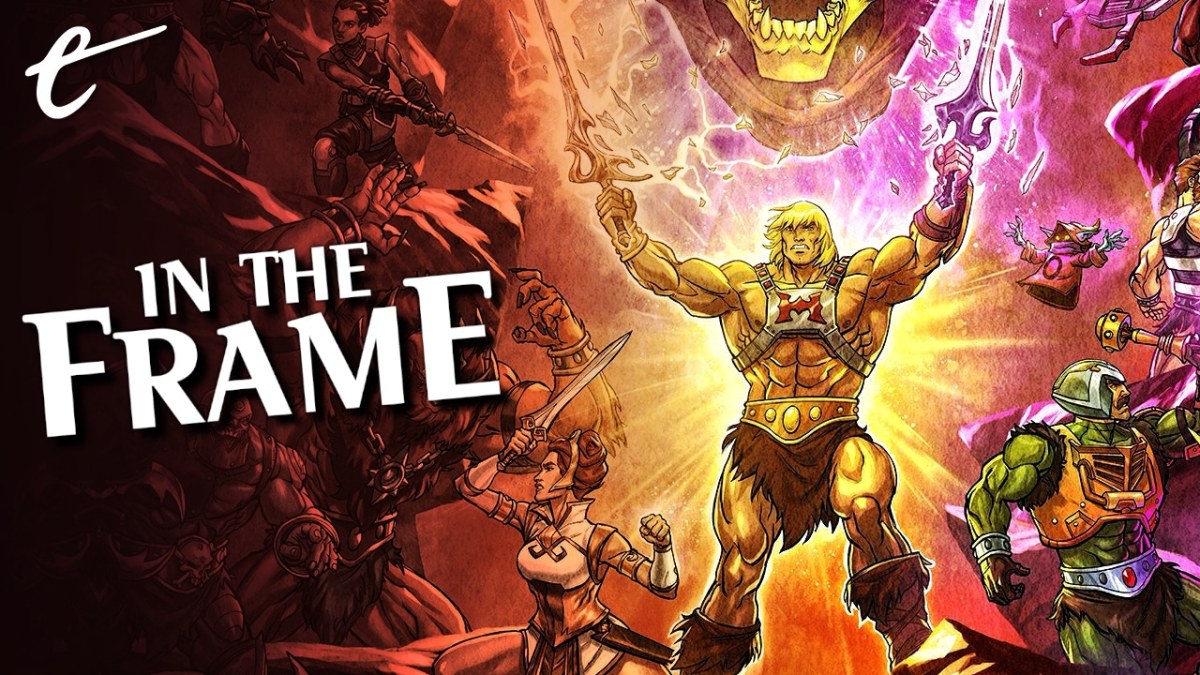This article contains significant spoilers for the first released block of episodes of Masters of the Universe: Revelation on Netflix. If you’re planning to watch it, bookmark this page and come back soon!
He-Man and the Masters of the Universe is not subtle in framing its central narrative as an archetypal battle between good and evil. The central constant of the franchise is a blonde-haired and muscle-bound warrior named “He-Man” locked in eternal battle against a monstrous blue man with a skull for a face (and a distinctive evil laugh) named “Skeletor.” Still, there is something interesting in how He-Man and the Masters of the Universe approaches its eternal struggle.
It is no surprise that the franchise’s basic narrative framework is relatively straightforward. After all, the entire multimedia empire was extrapolated out from a line of children’s toys. For designer Roger Sweet, that simplicity was part of the universal appeal of the toy. “I simply explained that this was a powerful figure that could be taken anywhere and dropped into any context because he had a generic name: He-Man!” says Sweet.
He-Man was transparently influenced by the culture of the time. There is, for example, a persistent (and false) urban legend that the toy line had its roots in Mattel’s aborted license to make toys tying into Arnold Schwarzenegger’s Conan the Barbarian film from 1982. However, a memo from Sweet suggested that the action figures should draw from the work of veteran fantasy artist Frank Frazetta “combined with parts of Conan, and Flash Gordon and Star Wars.”
Like much of its contemporary culture, Star Wars was an inescapable influence. Ted Mayer, who had worked as an illustrator on Star Wars before joining Mattel, explained, “He-Man came about because Mattel had turned down Star Wars, and was desperate to come out with an action figure line to rival [Kenner’s] Star Wars line.” This is obvious looking at Skeletor’s design. Writer Steven Grant suggested that Mattel was “going for a Darth Vader thing” with the villain. Masters of the Universe: Revelation casts Luke Skywalker himself, Mark Hamill, as Skeletor.

Like Star Wars, the world of He-Man and the Masters of the Universe blends science fiction and fantasy. There are swords and magic, but also technology and firearms. It is a world that is designed to feel lived in, with a rich history that extends beyond the present moment in both directions. It is no coincidence that He-Man and Skeletor battle one another on the world of “Eternia.” It is also a story about good and evil, light and darkness.
As the narrative behind the action figures came into focus, it drew from the work of Joseph Campbell. “Joseph Campbell’s concepts about myths and legends and icons are ingrained in all artists’ mentality,” recalls designer Mark Taylor. “If you’re going to tell a story, you need to understand Joseph Campbell.” Playing Skeletor in the film adaptation Masters of the Universe, actor Frank Langella rewrote a lot of the character’s dialogue by drawing from Campbell.
However, there is something distinct in how He-Man and the Masters of the Universe approaches the idea of good and evil. Epics like Star Wars frame these conflicts between good and evil as battles that can be won, wars in which one side triumphs and the other perishes. In Return of the Jedi, Luke Skywalker (Mark Hamill) reconciles with his father Darth Vader (David Prowse/James Earl Jones) while the Rebels finally defeat the Empire. These are stories, after all, and stories have third acts and endings.
He-Man and the Masters of the Universe offers an interesting counterpoint, largely resulting from its roots as a series of action figures. In its original and formative iteration, He-Man and the Masters of the Universe is not a story. Instead, it is a status quo, in which the target audience of children is asked to play out their fantasies with the action figures. As contemporary press coverage noted, children playing with the toys “tend to make up their own stories.”

Of course, there are other media that exist in states of a perpetual present without clear beginnings and endings, like comic books. However, even early appearances of characters like Batman tended to feature simple origin stories that provided a firm foundation for these figures, even if those same stories would be reworked and reimagined by various creators in the decades that followed. Some comic book characters even have iconic and influential (if out-of-continuity) final stories.
In contrast, the world of He-Man and the Masters of the Universe just was. Core concepts, like the relationship between He-Man and his alter ego Prince Adam, were reimagined and reworked in different media. Writer Michael Halperin struggled to reconcile the continuity of the micro-comics packaged with early toys, stating, “They did three or four of them prior to my coming aboard, and each one of them had a different origin story. It was as if everyone wanted to do their own thing.”
The most recent iteration of the franchise, Masters of the Universe: Revelation, directly acknowledges this blurred continuity. Embarking on an epic quest, Orko (Griffin Newman) urges his new companion Andra (Tiffany Smith) to keep a diary of her adventures if she wants to keep the chronology straight. “All my memories just blur together,” the Trollan confesses. For his part, showrunner Kevin Smith has described the show as both “a spiritual sequel” to and “a continuation” of the 1980s Filmation television series.
As such, most of the narrative of He-Man and the Masters of the Universe boils down to the toys themselves. The toy line delineates between good and evil, while also suggesting a symmetry. Halperin was originally hired by Mattel to create backstory because the kids playing with the toys needed to split them into sides. “Once they were on the market, children contacted the company because they were confused,” he explains. “Who were the good guys? Who were the bad guys?”

It is easy to understand how kids could be confused. Early characters like Beast Man were allocated an alignment based on the requirements of the toy line, “switching sides” for no narrative reason. In the early days, many of the toys were built from body parts and molds of other figures in the range. This is most obvious with Teela and Evil-Lyn, the heroic and villainous female figures that were very much built from the same model. Good and evil are often mirrored.
This interchangeability carried over from the toy line into the original television show, where many members of the cast would record multiple voices. Alan Oppenheimer voiced Skeletor, Man at Arms, and Mer-Man on the Filmation series. In the recording studio the actor “would do all three voices at the same time talking to (himself).” The result of all of this is to suggest a balance between good and evil within the world of He-Man and the Masters of the Universe.
This is perhaps most obvious with Castle Grayskull. The playset is the heart of He-Man’s universe. Mattel can reasonably describe it as “one of the most iconic playsets of all time,” while the opening narration of Masters of the Universe literally places it “at the center of the universe.” While the animated series treats Grayskull as He-Man’s headquarters, the castle traditionally occupies a more liminal space between good and evil, between light and dark. It does not belong exclusively to one or the other.
The playset is essential to the franchise mythology. As Rebecca Taylor notes, “The only chance Mark had to tell the story was with the castle.” Initially, He-Man and Skeletor each held half of the Sword of Power necessary to control Grayskull. The castle’s aesthetic arguably reflects Skeletor as much as He-Man. Rudy Obrero’s original box art depicted Skeletor inside the castle, holding it against He-Man. Skeletor controls Grayskull for the entirety of the feature film Masters of the Universe.

Good does not conquer evil in the world of He-Man and the Masters of the Universe. The two forces are at constant war with one another. There is no victory or defeat, just a battle waged in eternity. This is even reflected in the television series, where He-Man could not use his sword offensively against living antagonists and “never directly punched or kicked anyone” on the original show. As such, good never truly eliminated evil. Evil was only briefly routed, to try again.
This symmetry between good and evil carried over to Revelation. The new show introduces death and mortality to Eternia, but even that is in balance. In the first episode of the season, both He-Man (Chris Wood) and Skeletor (Hamill) are destroyed. It seems that one cannot exist without the other. When He-Man returns in the finale, Skeletor is revived alongside him. It seems that there must be balance on Eternia.
This balance extends beyond the franchise’s two most iconic characters. In the fourth episode, Orko sacrifices himself to dispatch Scare Glow (Tony Todd). Teela (Sarah Michelle Gellar) reluctantly finds herself teaming up with Evil-Lyn (Lena Headey) to save Eternia. Lack of balance is a problem. Teela struggles with the fact that Adam concealed his identity as He-Man from her. As Tri-Klops (Henry Rollins) embraces technology to the exclusion of magic, Eternia falls into chaos.
Many of these science fiction and fantasy narratives offer reassuring stories of good conquering evil. In The Lord of the Rings, the armies of Middle-earth manage to repel the corrupting influence of Sauron. In the Star Wars saga, Emperor Palpatine (Ian McDiarmid) is defeated twice. Even The Chronicles of Narnia ends with Aslan remaking the eponymous realm as paradise in the wake of its “darkest hour.” There is something reassuring in these stories, in the idea that good will triumph.
There is also something comforting in the approach that He-Man and the Masters of the Universe takes to good and evil, understanding that these two forces exist locked in everlasting battle. In the world of He-Man, evil is never truly vanquished and good can never truly rest. Instead, the two oppositional forces exist in tandem and locked in an eternal and unresolvable struggle. For a toy packaged and sold directly to children, there’s something very mature in that idea.






Published: Jul 23, 2021 11:00 am